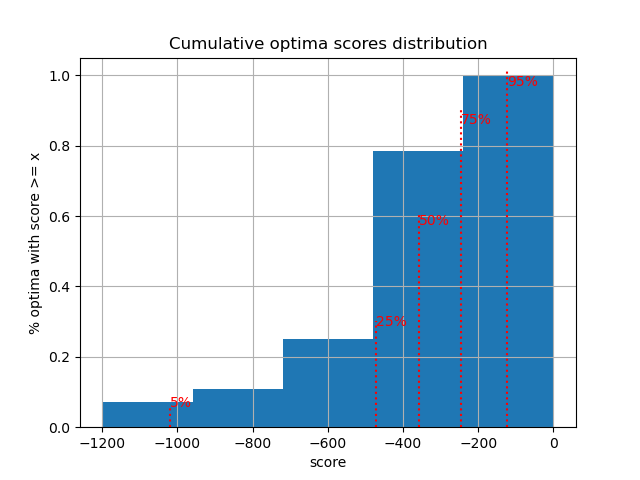A Python implementation of the Bees Algorithm based Local Optima Region Radius Extimator (BA-LORRE). This library allows an out-of-the-box use of the numerical optimisation algorithm on an user-defined target function. The algorithm can be configured to find the maxima of the target function with an iterative process.
Project description
BA-LORRE
A Python implementation of the Bees Algorithm based Local Optima Region Radius Extimator. Most of the intelligenent numerical optimization algorithms available are only made to find the global optimum of a given function. In contrast, the BA-LORRE is a swarm computation algorithm designed to find several local optima, avoiding already explored regions during the search.
The algorithm exploits the search properties of the Bees Algorithm to identify the position and radius of local optima region in a non-parametric way. Once identified, the local score of those regions is lowered, allowing the algorithm to focus furture search to unexplored regions.
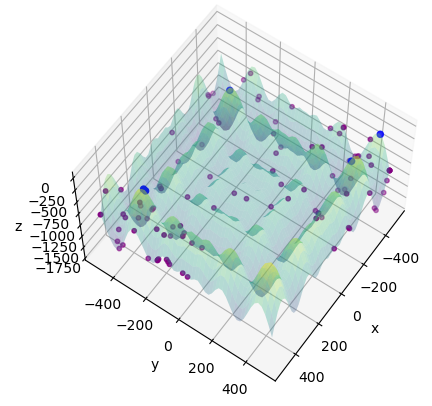 |
 |
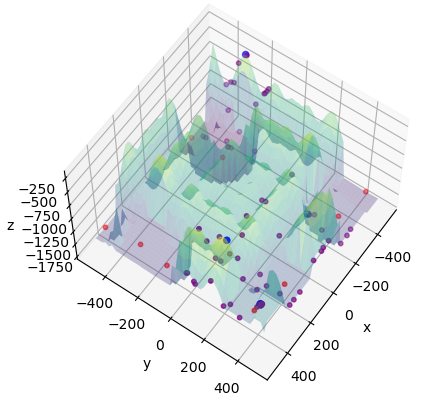 |
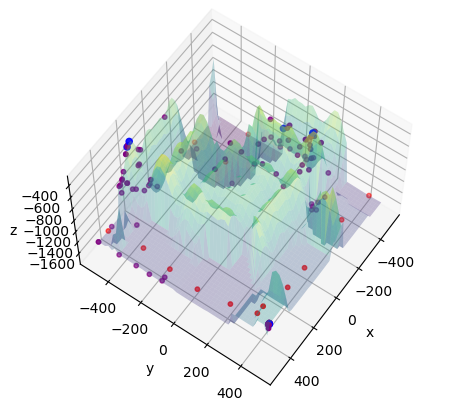 |
This library allows an off-the-shelf use of the algorithm to find the best local optima of an user-defined target function.
Reference
For details on the inner working of the BA-LORRE algorithm, how it's related on the Bess Algorithm and how the optima regions are found, please refer to this work.
If you are using this implementation of the BA-LORRE for your research, feel free to cite this work in your paper using the following BibTex entry:
@article{baronti2020analysis,
title={An Analysis of the Search Mechanisms of the Bees Algorithm},
author={Baronti, Luca and Castellani, Marco and Pham, Duc Truong},
journal={Swarm and Evolutionary Computation},
volume={59},
pages={100746},
year={2020},
publisher={Elsevier},
doi={10.1016/j.swevo.2020.100746},
url={https://doi.org/10.1016/j.swevo.2020.100746}
}
Installation
This module is available on pip and can be installed as follows:
$ pip3 install ba_lorre
Usage and Guidelines
As an extension of the original Bees Algorithm, the BA-LORRE shares most of the interface and mirrors its general usage.
The main class, LORRE, has the following signature (mandatory parameters in bold):
- score_function
: Callable[[list], float]the function that need to be optimised. It can either be a (lambda) function or a class that overrides the__call__function. Either way,score_function(solution: list) -> floatneeds to take a single parameter, a list of Nfloatrepresenting a position in the search space, and returns the score relative to that position; - range_min
: listlist of Nfloat, indicating the lower bound of the search space; - range_max
: listlist of Nfloat, indicating the upper bound of the search space; - nb
: intnumber of sites; - nrb
: intnumber of solutions sampled around each site, per iteration; - stlim
: intstagnation limit, the number of iteration required to abandon a site if no local progress is made; - initial_ngh
: listthe neighbourhood used for the local search in a site; - shrink_factor
: floathow much a neighbourhood must be shrunk per every iteration that its centre is not updated; - derating_radius_selection_criterion
: strthe criterion used to identify the optima region radius. Allowed values are median and topological; - derating_type
: strthe shape of penalty that will apply on every found region. Allowed values are flat and linear;
In this context N is the number of dimensions of the score function to be optimized. At each iteration nb x nrb solutions are evaluated in the search space. Examples of scores functions that can be used as a benchmark can be found in this library.
Please note that for simplicity this algorithm solves a maximization problem. If you need to minimize a function, please provide the opposite of the function (i.e. g(x)=-f(x)) to the algorithm. The found solutions won't be affected.
Please refer to the Bees Algorithm documentation for further details.
Initialization
The algorithm is first instantiated (as an example, here we are using a simple hyperbolic function to be optimized)
from ba_lorre import LORRE
alg = LORRE(lambda x: -pow(x[0]*x[1],2),
range_min=[-100, -100],
range_max=[100, 100],
nb=5, nrb=20, stlim=20,
derating_radius_selection_criterion='median',
derating_type='linear')
Optimization
Then the optimisation itself can be performed in different ways. The most simple method is calling performFullOptimisation specifying either the maximum number of iterations or the maximum score wanted as stopping criterion.
>>> alg.performFullOptimisation(max_iteration=50)
(50, -3.4228945713694973e-11)
This returns the number of iterations required and the score of the best solution found.
Alternatively, more control on the optimization process can achieved performing one iteration at a time this way:
alg.performSingleStep()
For score functions with 2 dimensions is possible to visualize the iterations of the algorithm calling
alg.visualize_iteration_steps()
This is often used for demonstration, debugging and to get a better insight on the algorithm dynamics. All the figures in this readme have been taken this way.
Found Optima Handling
The aim of the algorithm is to return the best local optima of a function. Once the optimization process is terminated the found optima can be collected with
alg.getFoundOptima()
which will return the position of the found optima.
For score functions with 2 dimensions is possible to visualize the found optima directly on the function's surface with:
alg.showFoundOptima()
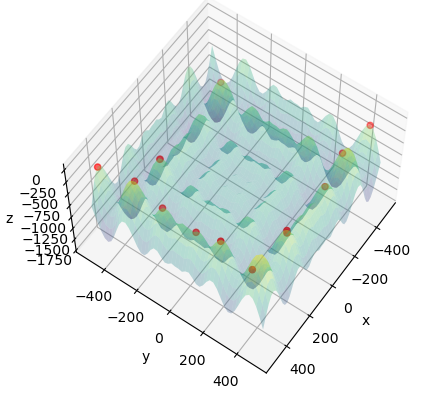
Pruning Criteria
The algorithm has no prior information on how many local optima the score function is supposed to have. As a result, spurious and redundant optima can be returned.
For this reason, this library comes with a set of pruning functions that can be passed to getFoundOptima or showFoundOptima to eliminate solutions that are unlikely to be a good approximation of real optima.
Available pruning classes are:
- PruningProximity putative optima that have been generated at the same time in the same region of an optimum of higher score are removed;
- PruningAbsScoreCutoff putative optima with a score lower than the cutoff parameter, are removed;
- PruningPercScoreCutoff putative optima with a score lower than cutoff% of the other optima are removed;
Any number of pruning criteria can be combined:
from ba_lorre import PruningProximity, PruningPercScoreCutoff
alg.getFoundOptima(pruning_functions=[PruningProximity(), PruningPercScoreCutoff(cutoff=.5)])
The PruningAbsScoreCutoff and PruningPercScoreCutoff pruning criteria require insight on the optima distribution to be used properly.
To help the practitioner a convenience function to visualize the optima score distribution is provided:
alg.showOptimaScoreHistogram()
Versions History
v1.0.2
- minor fix with a parameters hint
v1.0.1
- minor visual fixes for pypi
v1.0.0
- first release
Project details
Release history Release notifications | RSS feed
Download files
Download the file for your platform. If you're not sure which to choose, learn more about installing packages.
Source Distribution
Built Distribution
File details
Details for the file ba_lorre-1.0.2.tar.gz.
File metadata
- Download URL: ba_lorre-1.0.2.tar.gz
- Upload date:
- Size: 24.6 kB
- Tags: Source
- Uploaded using Trusted Publishing? No
- Uploaded via: twine/3.8.0 colorama/0.4.4 importlib-metadata/4.6.4 keyring/23.5.0 pkginfo/1.8.2 readme-renderer/34.0 requests-toolbelt/0.9.1 requests/2.25.1 rfc3986/1.5.0 tqdm/4.57.0 urllib3/1.26.5 CPython/3.10.6
File hashes
| Algorithm | Hash digest | |
|---|---|---|
| SHA256 | 6804294783d33f6e5d28661bf3773fd6374f37b02a20fdeb4d8600c7191b5225 |
|
| MD5 | 1fe3ff847f398fa159183d3e5534f3e8 |
|
| BLAKE2b-256 | 18fa6747d9f7b8457ae045f4effd43a97fe0cd589f4fe12deb4f262692e84837 |
File details
Details for the file ba_lorre-1.0.2-py3-none-any.whl.
File metadata
- Download URL: ba_lorre-1.0.2-py3-none-any.whl
- Upload date:
- Size: 22.2 kB
- Tags: Python 3
- Uploaded using Trusted Publishing? No
- Uploaded via: twine/3.8.0 colorama/0.4.4 importlib-metadata/4.6.4 keyring/23.5.0 pkginfo/1.8.2 readme-renderer/34.0 requests-toolbelt/0.9.1 requests/2.25.1 rfc3986/1.5.0 tqdm/4.57.0 urllib3/1.26.5 CPython/3.10.6
File hashes
| Algorithm | Hash digest | |
|---|---|---|
| SHA256 | 3e7b0a21141087473ef5b5201f129c6358d56632f86fc1dbdd86ec2f1fda25ee |
|
| MD5 | 8531844b726865e8c9ee4dddc56bc4ca |
|
| BLAKE2b-256 | fde4a6cf86ca2c4787d5e0aca048176c3adb564636aa4c7a3baaddbf0077f1d1 |


